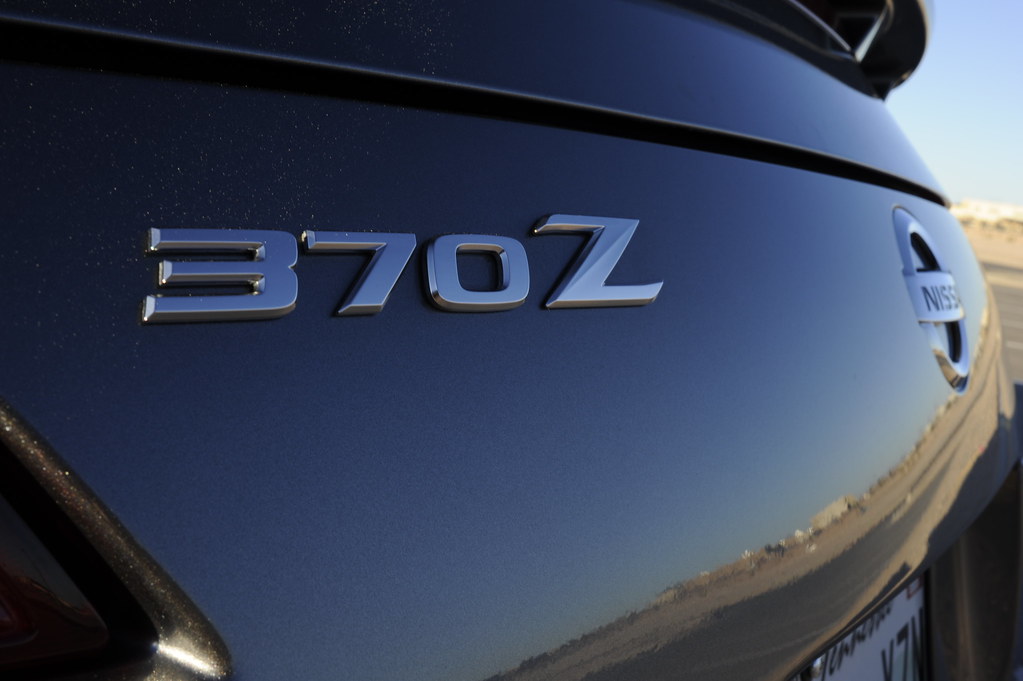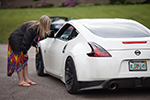
 |
I've been looking into getting a dslr for sometime now, but they were a bit too expensive, recently found out you can buy a used one for pretty cheap. The
|
|||||||
 |
|
|
LinkBack | Thread Tools | Display Modes |
|
|
|
|
#1 (permalink) |
|
Enthusiast Member
Join Date: Dec 2010
Location: Illinois
Posts: 321
Drives: 2011 370z 6mt sp
Rep Power: 15  |
I've been looking into getting a dslr for sometime now, but they were a bit too expensive, recently found out you can buy a used one for pretty cheap. The one specifically i was looking into is canon d5000. I wanted to know if its safe to buy a used dslr? The d5000 would be $350. Also is it safe to buy a factory demo camera? Also what is the name of a type of lens that allows for you to change the depth of field?
|
|
|

|
|
|
#2 (permalink) |
|
A True Z Fanatic
Join Date: Mar 2009
Location: So Cal baby!
Age: 52
Posts: 5,964
Drives: with passion
Rep Power: 322            |
I don't see any problem purchasing a used DSLR. And a factory demo? Used for what exactly? A DSLR has a "shutter life" so depending on how many times that things been fired that should play in to your decision. Of course it's kinda hard to figure that obviously.
As far as DOF or "depth of field" is concerned, that is largely controlled by your camera. Shallow DOF is typically characterized by heavily blurred backgrounds that you might see in outdoor portraits. DOF is controlled primarily by 3 different factors, the most common of which is the "F stop" or "F number" in an aperture mode or "AP - aperture priority" mode on your camera. (the lower the number, the more blurry the background). Now different lens's will offer you different types of "bokeh" or "blurriness" but it's not the lens itself that controls DOF. Another factor in DOF is simply the distance of your subject. Lastly, "focal length" will largely come into play when you are talking about lens's and the ability to shoot different DOF's. A short focal length lens will have a more difficult time achieving a shallow DOF whereas a telephoto lens will accomplish this with ease. I hope that helps! Last edited by KillerBee370; 11-26-2011 at 01:33 AM. |
|
|

|
|
|
#3 (permalink) |
|
A True Z Fanatic
Join Date: Jan 2011
Location: Fort Bliss, TX
Age: 41
Posts: 1,440
Drives: 2011 GM 370 base SP
Rep Power: 17       |
I would say killerbee pretty much has it all summed up. Any lens will let you mess with depth of field, that is controlled by the aperture. The an aperture of f/2.0 will have a much shallower depth of field than an f/22 assuming you are using the same lens in both instances. As Killerbee stated, your distance from the subject as well as the focal length also plays a big role on depth of field as well. My recommendation is that if you get a DSLR, get a good lens and go out and experiment with it. this way you learn your equipment better and you get to see how different variables affect the picture.
__________________
Srenity: "Yeah no rest needed to spread the love when your 20 that's for sure...." |
|
|

|
|
|
#4 (permalink) |
|
A True Z Fanatic
Join Date: Jan 2011
Location: Fort Bliss, TX
Age: 41
Posts: 1,440
Drives: 2011 GM 370 base SP
Rep Power: 17       |
Example:
This photo was taken with a 35mm lens at an aperature of f/2 at pretty close to it's minimum focus distance notice how small an area is actually in focus, the stuff behind the side marker was only about 2 feet away if that much:  This one is pretty close to minimum focus distance as well (same lens), just a much smaller aperture (iirc it was around f/22). Notice how much longer things stay in focus 
__________________
Srenity: "Yeah no rest needed to spread the love when your 20 that's for sure...." |
|
|

|
|
|
#8 (permalink) |
|
Enthusiast Member
Join Date: Dec 2010
Location: Illinois
Posts: 321
Drives: 2011 370z 6mt sp
Rep Power: 15  |
Thanks guys this was very helpful, I have one more question, what first lens should buy for a d5000 as I do not yet understand what all the mm mesurements mean.
Thanks |
|
|

|
|
|
#9 (permalink) |
|
A True Z Fanatic
Join Date: Jan 2011
Location: Fort Bliss, TX
Age: 41
Posts: 1,440
Drives: 2011 GM 370 base SP
Rep Power: 17       |
The lower the number the wider the angle. For example a 14mm has a much wider angle (field of view) than a 200mm. Another way to think of it is by zoom but generally you don't see that advertised on lenses, a 200mm would have a lot of zoom where as a 14mm wouldn't have any. For a good starter lens I would recommend a good 35-80mm zoom lens. If you want a prime lens (fixed focal length) I would say a nice 55mm would be a good all around lens. I'll get a few articles posted up for you too.
__________________
Srenity: "Yeah no rest needed to spread the love when your 20 that's for sure...." Last edited by Skeeterbop; 11-26-2011 at 04:37 PM. |
|
|

|
|
|
#10 (permalink) | ||
|
A True Z Fanatic
Join Date: Jan 2011
Location: Fort Bliss, TX
Age: 41
Posts: 1,440
Drives: 2011 GM 370 base SP
Rep Power: 17       |
Lots of reading but good info in these two links
From Canon EOS Beginners' FAQ III - Lenses Quote:
Quote:
__________________
Srenity: "Yeah no rest needed to spread the love when your 20 that's for sure...." Last edited by Skeeterbop; 11-26-2011 at 04:46 PM. |
||
|
|

|
|
|
#11 (permalink) |
|
Track Member
Join Date: Oct 2010
Location: Johnston RI
Posts: 857
Drives: 370 Touring Spt A/t
Rep Power: 16      |
I bought a demo Nikor Zoom 18-200 mm lens and its great! Make sure it comes with a money back guarantee, like any other product you buy.
I love the zoom because I get so many shots I might otherwise miss without all the hassle of changing a lens, not to mention the possibility of dropping the lens or getting dust on the sensor while changing lenses. Some of the purists think zooms are not as good as fixed lenses but imo unless you are blowing the pic up to the size of a wall or looking at it under a microscope, you cant tell the difference. One really important thing is to buy a name brand lens like Nikor or Cannon and stay away from the bargain basement ones. The colors often get shifted because of the inferior coatings and the resolution is not there. And dont get a great lens either and fail to protect it with a UV filter on the front or screw it up with a cheap filter either. No matter what kind of camera you have, no matter how advanced it is...if the lens is bad the pics will disappoint so dont be cheap! But to answer your question directly, I would have no problem buying a factory demo or refurbished lens.. its not like a car.. i mean, really, how much wear and tear does a lens get? |
|
|

|
|
|
#12 (permalink) |
|
A True Z Fanatic
Join Date: Jan 2012
Location: Cocoa, Florida
Age: 42
Posts: 5,075
Drives: Pantydropper machine
Rep Power: 34            |
Ok so where would be a good place to get a used camera for a good price? I would like to stay under $400 for a beginner camera to see if it's something I'm even going to be into.
Sent from my iPizzle using magic and new fangled science stuff
__________________
 VLEDS | Evo-R | Moddiction | CF Hood Struts | F.I. CF CBE & LTH | Stillen CAI | NST Pulleys | UpRev | Z1 | M7 | Status | Forgestar | PSS | Whiteline | SPL | SPC | Kenwood | Zenclosure | Kicker | Alpine Type R
|
|
|

|
 |
| Bookmarks |
|
|
 Similar Threads
Similar Threads
|
||||
| Thread | Thread Starter | Forum | Replies | Last Post |
| DSLR advice | Red__Zed | Photography | 48 | 08-29-2013 09:04 PM |
| Buying DSLR: Thoughts on Canon 60D and 18-200 IS lens? | wheee! | Photography | 1 | 10-18-2011 11:48 PM |
| Buying a new Z question !!!! IMPORTANT | ephan | New 370Z Owner | 0 | 08-06-2011 05:37 PM |
| Thinking of buying, question about high mileage | gizmo8500 | Nissan 370Z Pricing / Ordering Discussions | 6 | 01-17-2011 10:15 AM |
| Question About Future Buying (Nismo) | 370zlove3 | Nissan 370Z Pricing / Ordering Discussions | 43 | 12-11-2009 01:32 PM |